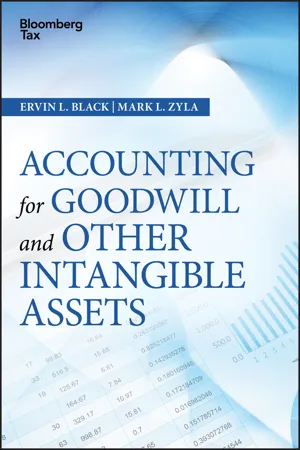
- English
- ePUB (mobile friendly)
- Available on iOS & Android
Accounting for Goodwill and Other Intangible Assets
About this book
Concepts, methods, and issues in calculating the fair value of intangibles
Accounting for Goodwill and Other Intangible Assets is a guide to one of the most challenging aspects of business valuation. Not only must executives and valuation professionals understand the complicated set of rules and practices that pertain to intangibles, they must also be able to recognize when to apply them. Inside, readers will find these many complexities clarified. Additionally, this book assists professionals in overcoming the difficulties of intangible asset accounting, such as the lack of market quotes and the conflicts among various valuation methodologies.
Even the rarest and most problematic situations are treated in detail in Accounting for Goodwill and Other Intangible Assets. For example, the authors analyze principles for identifying finite intangible assets and appropriately accounting for amortization expenses or impairment losses. Using the information in this book, the results of these calculations can also be reported with precision on financial statements. These topics are especially important for ensuring the success of any asset acquisition or business combination. In these special cases, the utmost accuracy is essential. This book provides:
- Rules for identifying and recognizing intangible assets in business combinations and asset acquisitions
- Guidance on the accurate valuation and carrying amount calculation of acquired and self-created intangibles
- Tips for overcoming the challenges unique to intangible assets, including impairment testing
- Clear instructions for disclosing intangible assets, goodwill, and amortization expenses
Accounting for Goodwill and Other Intangible Assets is an indispensable reference for valuation students and specialists. Ervin L. Black and Mark L. Zyla provide thorough instructions for understanding, accounting for, and reporting this challenging asset class.
Frequently asked questions
- Essential is ideal for learners and professionals who enjoy exploring a wide range of subjects. Access the Essential Library with 800,000+ trusted titles and best-sellers across business, personal growth, and the humanities. Includes unlimited reading time and Standard Read Aloud voice.
- Complete: Perfect for advanced learners and researchers needing full, unrestricted access. Unlock 1.4M+ books across hundreds of subjects, including academic and specialized titles. The Complete Plan also includes advanced features like Premium Read Aloud and Research Assistant.
Please note we cannot support devices running on iOS 13 and Android 7 or earlier. Learn more about using the app.
Information
CHAPTER 1
Recognizing Intangible Assets
A. Introduction and Background
Comment
- Dell allows built-to-order computers (customers design their own computers).
- Wal-Mart has a supply chain that essentially shifts its inventory management to its suppliers. (Wal-Mart's smaller competitors cannot duplicate this supply chain.)
- Benetton, an Italian apparel manufacturer, has a unique information system relaying real-time information about product colors between stores and manufacturing facilities.
- Citibank has an online (internet-based) banking system that allows it to seek customers all over the world. Moreover, the synergy between different parts of the banking system, such as mortgages and credit cards, is high.8
| Trademarks, trade names | Service marks, collective marks, certification marks |
| Trade dress (unique color, shapes, or package design) | Newspaper mastheads |
| Internet domain names | Not-to-compete agreements |
| Customer lists | Order or production backlog |
| Customer contracts and related customer relationships | Noncontractual customer relationships |
| Plays, operas, ballets | Musical works such as compositions, song lyrics, or advertising jingles |
| Pictures, photographs | Video and audiovisual material |
| Licensing, royalty, standstill agreements | Advertising, construction, management, service, or supply contracts |
| Lease agreements | Construction permits |
| Franchise agreements | Operating or broadcast rights | ...
Table of contents
- Cover
- Table of Contents
- Introduction
- CHAPTER 1: Recognizing Intangible Assets
- CHAPTER 2: Initial Measurement of Acquired Intangible Assets
- CHAPTER 3: Amortizing Intangible Assets
- CHAPTER 4: Impairment Testing for Goodwill and Other Intangible Assets
- CHAPTER 5: Financial Statement Presentation and Disclosures
- CHAPTER 6: Deferred Tax Consequences of Goodwill and Intangible Assets
- Working Papers
- About the Authors
- Index
- End User License Agreement